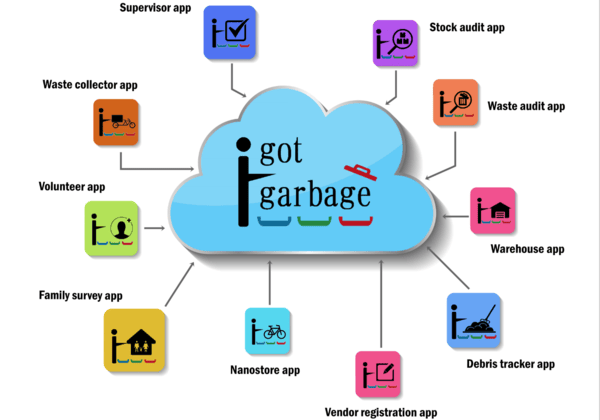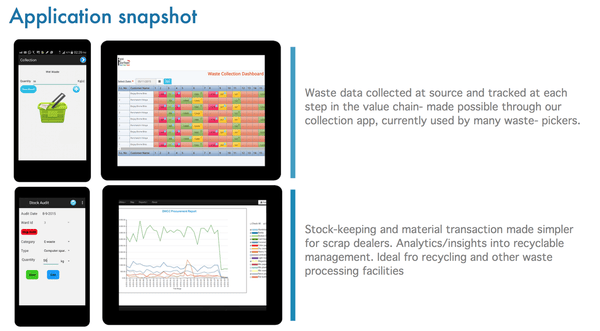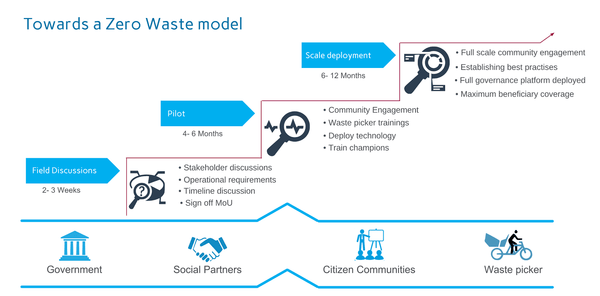
What’s I Got Garbage today?
IGG is an initiative in the area of Solid Waste Management (SWM) and waste-picker livelihood. It aims to help cities to manage their waste better with the involvement of four major stakeholders: the government, social and NGOs, citizens, and waste-pickers.
IGG partners with several organisations in the waste sector in Bengaluru including Hasiru Dala, the Solid Waste Management Round Table (SWMRT), the Clean City Recyclers Association (CCRA), and Waste Wise Management and Consulting Services (WWM&CS). It is based on a cloud digital platform that offers suite of integrated business services, accessed by easy-to-use mobile apps tailored for each of the waste management’s stakeholders.
IGG supplements its mobile apps by providing city-level assessment and planning support for sustainable SWM, training, solution modelling, roadmap definition as well as equipping SWM stakeholders with a technology platform to support the entire scope of operations. Its services cover door-to-door collection, dry waste donation, community composting and citizen engagement.
Started in 2013, IGG’s main goal is to provide a way for rag-pickers to formalise their activities as well as creating a digital marketplace for waste to be traded in a fluid manner in between generators and collectors, to achieve sustainable disposal and recycling. In addition, great expectations were put forward regarding the scalability of the platform across Indian cities. As of today, IGG has met some of these expectations by having started servicing cities like Bengaluru, Pune, Varanasi, Hajipur and Bhubaneshwar.

A useful analogy to understand how IGG works is to take the example of Amazon and how it connects sellers and buyers together by making sure each steps of the supply chain goes well. In the case of IGG, buyers are waste-pickers and sellers are the citizens producing waste; however, at the moment both have small incentives to get together outside the existing system put into place by municipalities – a system that has proved ineffective in Bangalore. “Incentive” is the keyword here to understand why such model as IGG’s has not spread more widely.
A great vision on a rocky road
Thus, as Karan Rai Bahadur – co-founder of IGG – puts it:
“it’s been a very challenging and exciting journey so far, and we’re somewhere there in terms of standardizing the field approach and getting the right support from various stakeholders we work with across the country.”
IGG is facing several issues that delay its expansion and the realisation of its goals. First amongst them is the low awareness amongst citizens as for why one should segregate, let alone put some effort and time in organising an alternative to municipal waste collection. There is high resistance from the citizens to the concept that one should pay for collection of garbage. Here “pay” could be understood as the opportunity cost of having to do more than just drop one’s garbage at one’s doorstep for the waste collectors to come and pick – or just a collection fee. In short, for people to get out of their way to dispose of their waste, they need both incentives and more awareness.
Adding to the conundrum, currently the waste collection model in Bangalore is built in a way that incentivises contractors to increase their tonnage of waste they send to the landfill. This is done by connecting remuneration with total weight of waste. Furthermore, small financial resources leaves them little space to care for more sustainable ways of disposing garbage other than just sending it to the landfill. IGG claims that 270-300 Rs. per month is a good estimation of how much door-to-door collection should be charged per unit in order to cover costs and enable contractors to correctly segregate and dispatch waste.
Another limit to IGG’s growth pertains to the level of flexibility and adaptability each of its apps requires in order to be accessible and usable by the different stakeholders. For instance, waste-pickers or the staff working at Dry Waste Collection Centres (DWCC) can have a hard time using apps to enter data or just organise picking of waste. Offering apps that are resilient in terms of languages and usability is a big challenge for IGG that requires tedious development; low digital literacy of waste-pickers is only one example of how mobile apps can be limited in practice.
“Establishing the waste-pickers as Independent Entrepreneurs is central to everything we do. And we believe that technology can be a great enabler in helping them operate in a more formal sector with access to markets and dignified livelihood opportunities. When it comes to technology adoption we’re constantly undertaking user fields studies to understand how best we can make technology user friendly for them” adds Karan.
All these resulted in an ongoing development process that has become greater in scope as initially thought at IGG’s beginnings.
How does IGG intend to overcome such limitations?
Hence, growth has not been as high as initially expected for IGG. From 5,000 ragpickers on board in 2014, they now have around 10,000. Taking into account the above mentioned limitations, IGG has adopted two main strategies for further growth. The first one is to let its partners take a call on where they want to develop:
“It completely depends where our social partners want to expand first, because they have limited resources and making the market sustainable for them will take time. It starts with sensitization and awareness campaigns for citizens where over a course of engagement they begin to understand the importance of responsible and sustainable waste-management. The idea is to make the citizens realize and relate to the problems that the waste-pickers face and the challenges pertaining to increasing garbage in cities. The socio-economic and environmental challenges of waste management need to be at the forefront of our public discourse. ” says Karan.
However, until citizens are willing to pay more for waste collection, IGG’s partners will find it rather hard to expand.
The second strategy is a pilot project: the zero-waste ward model. Karan explains:
“What we do is: we tell the municipality let’s pick a particular ward, and make it zero waste, that means that the entire dry waste is collected separately, the organic waste is composted within the ward, and rejects are the only waste leaving the ward to a designated landfill – which amounts between 5 to 7% of the total waste”.
The pilot projects includes activities such as assessment and planning, infrastructure deployment, public awareness campaigns, waste-pickers training, technology deployment, results monitoring, and learning. Once the pilot project is successful, IGG can then scale it to the entire city. The city of Hazaribagh is an instance where such pilot was successful with the help of local NGOs and social enterprises with the support of the municipality and members from Parliament. It took 6 months to make the ward “zero waste”.
As a result, IGG is currently working on the city expansion plan based on that successful pilot and the field knowledge it acquired in that particular ward. This is now the model that IGG is trying to adopt across cities in India, a model based on the cooperation of 4 crucial stakeholders: the government, the NGOs and social enterprises, the citizens and the waste-pickers. These four stakeholders, if willing, can create the enabling environment for IGG to integrate its platform.
What’s the issue in Bengaluru?
In the case of Bangalore, IGG has to face one big issue: the lack of involvement of local authorities – the BBMP. So far, the pilot model has not been successful in Bengaluru due to the lack of the municipality’s participation as well as low levels of awareness among citizens. Consequently, IGG had to resort to its first growth strategy: letting social enterprises and NGOs – such as Hasiru Dala – develop where they see fit. Though Bengaluru can count on a strong citizen group base, scaling up operations across the city would require more municipal involvement.
When will can we expect to see results?
“The pilots across cities generally lead to serious results in a 6 months to 1 years span, depending upon the local complexities in the waste ecosystem. Also in order to develop a holistic approach we have been working with Tier 1, 2 and 3 cities, instead of only focusing on the metropolitans,” concludes Karan.
Related Articles